Defining
the Inuit Dog
Canis familiaris borealis
by Sue Hamilton
Canis familiaris borealis
by Sue Hamilton
© December 2011, The
Fan Hitch, all rights reserved
revised: December 2020
revised: December 2020
I.
Introduction
A.
The
Inuit Dog’s place in the natural world
B. The Inuit Dog is not a wolf!
C. Dangerous confusion
B. The Inuit Dog is not a wolf!
C. Dangerous confusion
A. The Name Controversy
B. Defining 'Purity'
C. Mistaken Identity: Promoting a breed vs. avoiding
extinction
D. The Belyaev Experiment
E. Summary
B. Defining 'Purity'
C. Mistaken Identity: Promoting a breed vs. avoiding
extinction
D. The Belyaev Experiment
E. Summary
A. Ancient
history
B. Recent history: The Inuit Dog in service to nations
B. Recent history: The Inuit Dog in service to nations
1. Exploration
2. War
3. Sovereignty
2. War
3. Sovereignty
C.
Population
decline
A. In the North
B. Below the tree line
B. Below the tree line
A.
Inherited
diseases
B. Disease prevention and access to veterinary services
B. Disease prevention and access to veterinary services
A.
Appearance
B. Behavior
C. Performance
D. The big picture
VII. The Inuit Dog in
Scientific Research, Films andB. Behavior
C. Performance
D. The big picture
in Print
VIII. Acknowledgements
Appendix 1: Partial list of scientific publications about
the Inuit Dog
Appendix 2: Selected (alphabetical) list of other resources
with a focus on Inuit Dogs
Appendix 3: A small sampling of other resources of
interest
Navigating This Site
Index of articles by subject
Index of back issues by volume number
Search The Fan Hitch
Articles to download and print
Defining the Inuit Dog
Ordering Ken MacRury's Thesis
Our comprehensive list of resources
About The Fan Hitch
Talk to The Fan Hitch
The Fan Hitch home page
Editor-in-Chief: Sue Hamilton
Webmaster: Mark Hamilton
The Fan Hitch,
Journal of the Inuit Sled Dog, is published
four times a year. It is available at no
cost online at: https://thefanhitch.org.
The Fan Hitch welcomes your letters, stories, comments and suggestions. The editorial staff reserves the right to edit submissions used for publication.
Contents of The Fan Hitch are protected by international copyright laws. No photo, drawing or text may be reproduced in any form without written consent. Webmasters please note: written consent is necessary before linking this site to yours! Please forward requests to Sue Hamilton, 55 Town Line Rd., Harwinton, Connecticut 06791, USA or mail@thefanhitch.org
This site is dedicated to the Inuit Dog as well as related Inuit culture and traditions. It is also home to The Fan Hitch, Journal of the Inuit Sled Dog.
The Fan Hitch welcomes your letters, stories, comments and suggestions. The editorial staff reserves the right to edit submissions used for publication.
Contents of The Fan Hitch are protected by international copyright laws. No photo, drawing or text may be reproduced in any form without written consent. Webmasters please note: written consent is necessary before linking this site to yours! Please forward requests to Sue Hamilton, 55 Town Line Rd., Harwinton, Connecticut 06791, USA or mail@thefanhitch.org
This site is dedicated to the Inuit Dog as well as related Inuit culture and traditions. It is also home to The Fan Hitch, Journal of the Inuit Sled Dog.
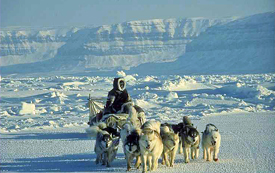
Devon Island in the Canadian Arctic
Corel Arctic
V. Health
A. Inherited diseases
The Inuit Dog is known to be
a robust, hearty and healthy animal. It is, however, not
free of inherited or other diseases. Without access to
veterinary pathology service in the Arctic, some of the
reasons dogs die or are killed most often go undiagnosed.
In Antarctica, a huge body of knowledge was generated by
the British Antarctic Survey veterinarians who studied the
dogs' anatomy, physiology, nutrition, occupational and
inherited diseases, work output.1
Outside polar regions, cataracts, cancers, endocrine
diseases and bloat have been identified.
The extremely harsh selection process of the arctic environment, along with sound judgment on the part of their owners, dictates that only the fittest examples reproduce. As mentioned in IV B, it is worth repeating here that owners keeping these dogs outside of their native habitat unchallenged by polar conditions are encouraged to take full advantage of veterinary diagnostic technology to screen for debilitating inherited ailments such as hip dysplasia and endocrine diseases, as well as poor reproductive performance so that these animals may be removed as breeding stock, hopefully before a prevalence of their deleterious genes predominate in future generations.
B. Disease prevention and
access to veterinary servicesThe extremely harsh selection process of the arctic environment, along with sound judgment on the part of their owners, dictates that only the fittest examples reproduce. As mentioned in IV B, it is worth repeating here that owners keeping these dogs outside of their native habitat unchallenged by polar conditions are encouraged to take full advantage of veterinary diagnostic technology to screen for debilitating inherited ailments such as hip dysplasia and endocrine diseases, as well as poor reproductive performance so that these animals may be removed as breeding stock, hopefully before a prevalence of their deleterious genes predominate in future generations.
Unfortunately, upon
returning home from the 2008 Nunavut Quest, many dogs
became sick and died due to communicable diseases that
could have been prevented with proper vaccinations. An
unnecessary tragedy, this was not the first time epidemics
of distemper and parvovirus, spreading from community to
community, have decimated populations of northern sled
dogs.
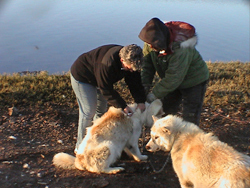
A Canadian Animal Assistance Team member
vaccinates a sled dog as its owner assists.
Photo courtesy of CAAT
Because rabies is a zoonotic disease and
considered endemic among wild arctic mammals such as
foxes and wolves, thus posing a risk to domestic dogs
and therefore to humans, a program of rabies vaccine
administration in northern communities is well
established. However, based on comments received from
several northern residents, there is no consistent,
reliable program to protect working sled dogs (and
therefore the needs of their owners, many of whom
continue to rely on dogs for tourism income as well as
some hunting and fishing for the preferred "country
food" diet) against other preventable diseases which
are not considered a threat to humans. The two-pronged
problem is that a) according to Canadian law, vaccines
to prevent distemper, parvovirus, coronavirus and
other communicable dog disease that either exist in
wild canids and can be transmitted to domestic ones or
are introduced into the arctic, brought north by dogs
from outside the region, cannot be administered [by a
veterinarian] unless that professional has personally
examined the dogs being vaccinated and b) it is not
legal for lay individuals such as dog team owners to
obtain such vaccines.
Right now, there are almost no permanent veterinary clinics that routinely service the needs of northern communities. These needs include: vaccination, spaying and castrating, wound management, miscellaneous other medical/surgical interventions, first aid training, bite prevention training for community children. Veterinary medical support is a service that is needed and sought out by northern mushers as well as the burgeoning number of owners of non-aboriginal pet dogs now living in a polar climate. Options are few: send a dog south on an expensive airlift to Ottawa or Montreal, airline hubs where veterinary care is available or mushers treat the problem themselves as best they can, sometimes resorting to a bullet to end suffering.
Right now, there are almost no permanent veterinary clinics that routinely service the needs of northern communities. These needs include: vaccination, spaying and castrating, wound management, miscellaneous other medical/surgical interventions, first aid training, bite prevention training for community children. Veterinary medical support is a service that is needed and sought out by northern mushers as well as the burgeoning number of owners of non-aboriginal pet dogs now living in a polar climate. Options are few: send a dog south on an expensive airlift to Ottawa or Montreal, airline hubs where veterinary care is available or mushers treat the problem themselves as best they can, sometimes resorting to a bullet to end suffering.
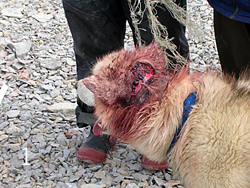 |
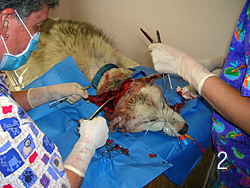 |
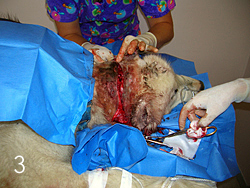 |
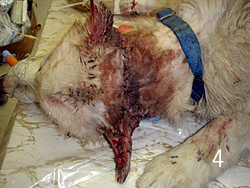 |
This dog was lucky.
Although his fight wound was not fresh,
the Canadian Animal Assistance Team was in the community
in time to successfully surgically repair it. Photo: CAAT
the Canadian Animal Assistance Team was in the community
in time to successfully surgically repair it. Photo: CAAT
While Greenland has a veterinary network
system, in Canada there are but a few traveling
veterinarians who may show up once or twice a year to
some of the larger communities such as Iqaluit,
Nunavut's capital. There are volunteer teams of
veterinarians and technicians such as the University
of Prince Edward Island, Canada Atlantic Veterinary
College's The
Chinook Project
which, as long as their program continues to receive
grant support, makes an annual pilgrimage to a northern community. Similarly, the Canadian Animal
Assistance Team
sends crews of veterinarians and technicians to
communities across the Canadian North as financial support permits. Quite often
these visits are the very first introduction to the
concept of medical care for dogs and both the Chinook
Project and CAAT have ever so gently introduced
traditional concepts on animal keeping practices to
modern technology alternatives such as preventative
medicine, including spaying and castration, for
improved health and work performance. The Chinook
Project and the Canadian Animal Assistance Team have
been sought out by and invited into northern
communities. These professionals come without
prejudice or proselytizing. They take an attitude of
unselfish service, performing only those procedures
they are asked to do, with their enthusiasm
encouraging the community's interest and imagination
and showing by example all the good that can be done
for their dogs and thus for them as well. Both of
these organizations report back describing the
overwhelming support and gratitude for their services
(only performed when asked) which range from
vaccinations and de-wormings to spays and castrations,
surgical repairs of wounds, tumor excisions and
general education programs on veterinary first aid and
dog bite prevention for children.2
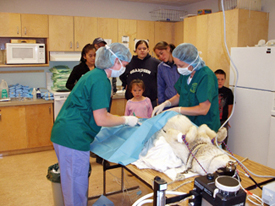
Chinook Project veterinarians spay a sled dog
during one of the organizations wellness clinics
in Nunavut, Canada. Perhaps some of the audience
will be inspired to become veterinarians.
Photo: Jane Magrath, Chinook Project
2The appreciation expressed by northern dog owners of both pets and working sled dogs to these volunteer efforts would seem to indicate that the Canadian North needs permanent veterinary centers in their major "hubs", where most airline routes travel to and from, to be staffed by professionals who can organize a system whereby all necessary vaccines are always available and there are trained paraprofessionals, similar to physicians' assistants for humans, to administer them, to serve as the long-distance eyes and hands of the clinic's veterinarian, to teach basic first aid skills and do whatever else the dog owning community needs. But more than that, such a network of support can work in concert with local wildlife biologists and hamlet hunter and trapper organizations to monitor the health of terrestrial and marine mammals and birds, destined to become country food for humans. Zoonotic diseases, illnesses transmissible from animals to humans by various routes, come in more "flavors" than just rabies.